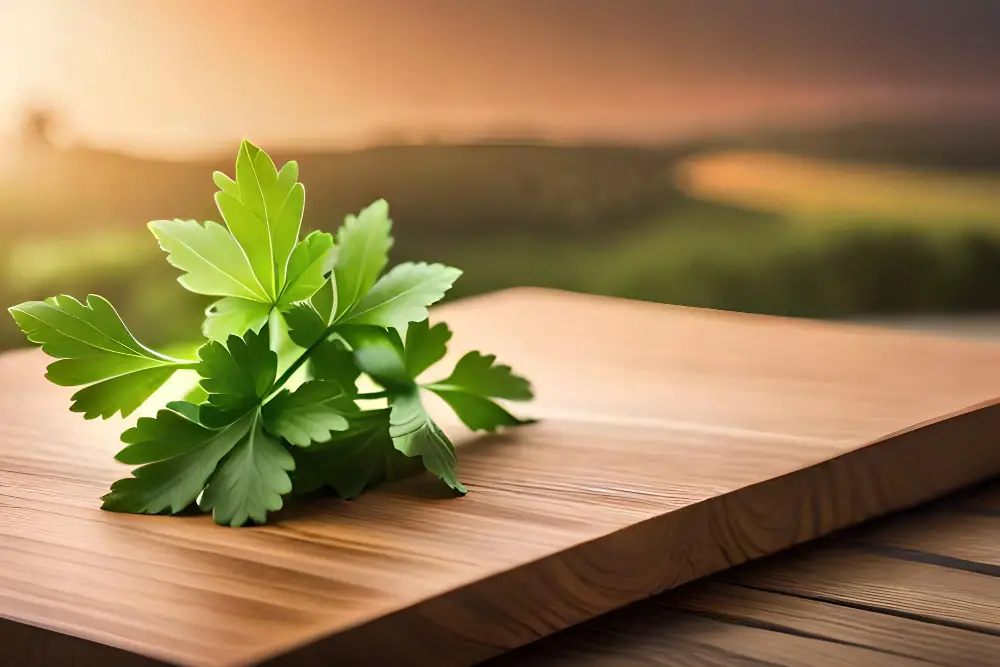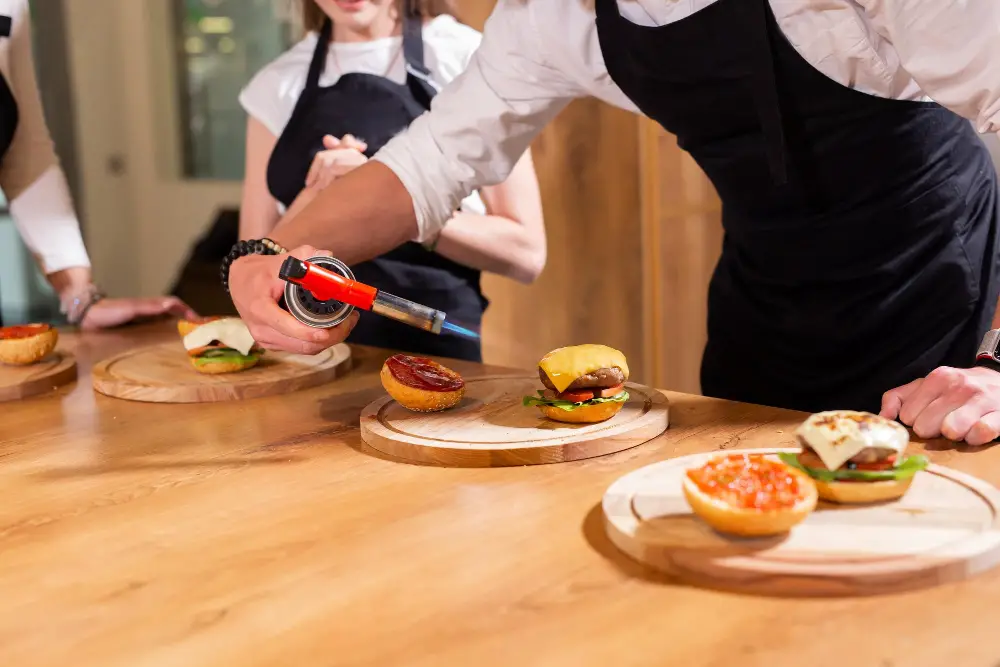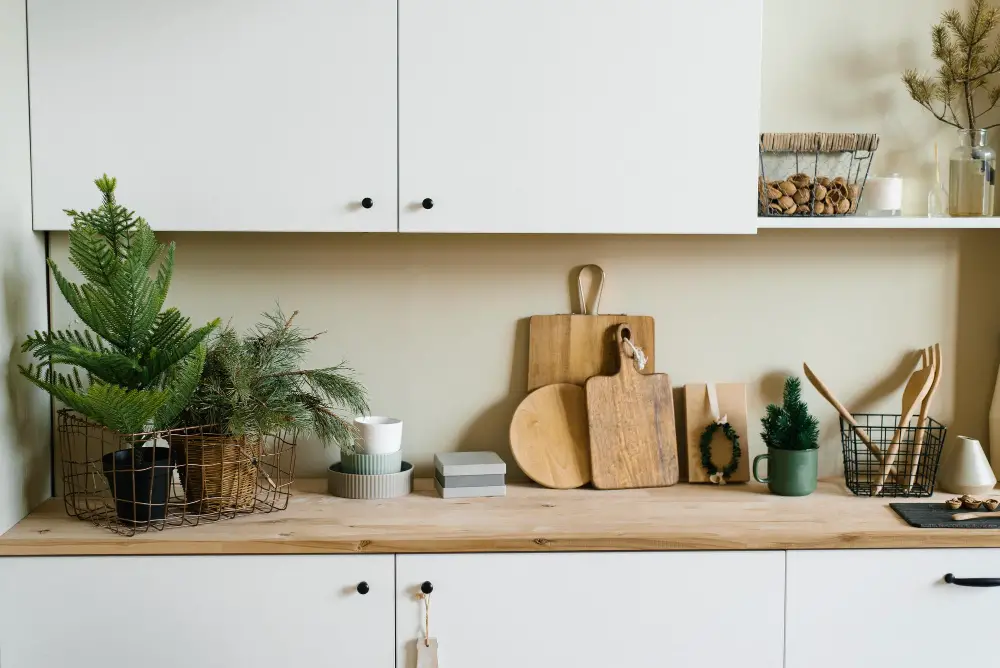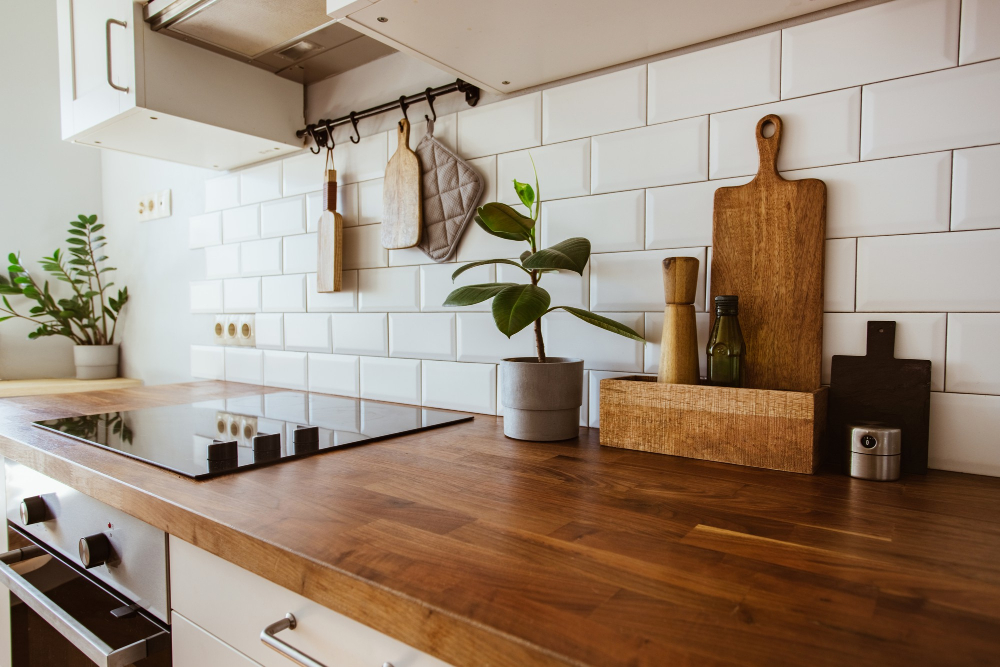Last updated on
Discover the art of displaying cutting boards on your kitchen counter to enhance aesthetic appeal and functionality with our easy-to-follow tips.
The kitchen is the heart of every home, and it’s no surprise that we all want to keep our kitchens looking beautiful and organized. One way to add both style and functionality to your kitchen counter is by displaying cutting boards.
Not only do they serve as a practical tool for meal preparation, but they can also be a decorative element that adds character to your space. In this article, we’ll share some creative ideas on how to display cutting boards on your kitchen counter while keeping them easily accessible for everyday use.
So let’s get started!
Key takeaways:
- Display cutting boards on kitchen counter or shelf.
- Cluster them together against the wall.
- Use a designated pull-out drawer to minimize clutter.
- Use hardwood cutting boards for durability and attractive patina.
- Get creative with arranging cutting boards vertically or hanging them on hooks.
What's Inside
Introduction to Cutting Board Display

Cutting boards are an essential tool in every kitchen, but they can also be a stylish addition to your decor. Displaying cutting boards on your kitchen counter is not only practical but can also add character and warmth to the space.
Whether you have a collection of vintage cutting boards or just want to showcase your favorite ones, there are many creative ways to display them that will enhance the aesthetic appeal of your kitchen.
In this article, we’ll explore different types of cutting board displays and provide tips on how to choose the right size for optimal functionality while still maintaining an attractive appearance. We’ll discuss various styles for displaying cutting boards such as flat or upright displays and utilizing stands or wall features.
We’ll also cover ideas for incorporating cutting board displays into small kitchens without sacrificing valuable countertop space. We will share maintenance tips so that you can keep both your countertops and displayed items looking their best.
Types of Cutting Boards

Each type has its unique features and benefits that make them suitable for different purposes. Some of the most common types include wooden, plastic, bamboo, glass and marble cutting boards.
Wooden cutting boards are a classic choice that adds warmth to your kitchen decor while being gentle on knives. They require regular oiling to maintain their quality but can last for years with proper care.
Plastic cutting boards come in various colors and sizes making them easy to clean and sanitize after use. They’re also lightweight which makes them ideal for outdoor activities like picnics or camping trips.
Bamboo is an eco-friendly option that’s durable yet gentle on knives due to its natural hardness properties. It’s also resistant against bacteria growth which makes it a hygienic choice for food preparation.
Glass or marble cutting boards offer a sleek look but can be hard on knife blades over time if not used properly as they do not have any give when you cut into them.
Choosing the Right Size

First and foremost, you want to make sure that the cutting board fits comfortably on your kitchen counter without taking up too much space. A good rule of thumb is to choose a cutting board that is proportional in size with your countertop.
Another factor to consider when selecting the right size is how often you use your cutting boards. If you’re an avid cook who uses multiple boards at once, then having larger-sized ones may be more practical for meal prep purposes.
On the other hand, if you have limited counter space or only use one or two small-sized boards regularly, then opting for smaller sizes would be more appropriate.
Ultimately, choosing the right size depends on personal preference and lifestyle needs.
Display Styles for Cutting Boards

The style you select will depend on the size and number of cutting boards you have, as well as the overall look and feel of your kitchen.
One popular display style is a flat or upright display. This involves placing the cutting board flat against a backsplash or wall, or standing it up vertically against other items such as cookbooks or utensil holders.
This method works well for smaller kitchens with limited counter space.
Another option is utilizing stands designed specifically for holding multiple cutting boards at once. These stands come in various sizes and materials such as wood, metal, acrylics among others that complement different decor themes.
For those who want to make a statement with their displays while saving countertop space simultaneously; creating an eye-catching wall feature by hanging multiple sized-cutting boards can be an excellent choice too!.
Flat or Upright Display

A flat display is the most common and involves laying the cutting board horizontally on your countertop. This style works well for larger cutting boards that can double as serving platters or cheeseboards.
On the other hand, an upright display is a great option if you have limited counter space but still want to showcase your collection of smaller cutting boards. You can use a plate stand or easel to prop up each board vertically against backsplash tiles, creating an eye-catching feature in your kitchen.
Both styles offer unique benefits and add character to any kitchen decor scheme while keeping essential tools within reach during meal prep time.
Utilizing Cutting Board Stands

These stands come in various sizes, materials, and designs that can complement any kitchen decor. Utilizing cutting board stands is an excellent option for those who have limited counter space or want to keep their counters clutter-free.
One popular type of stand is the vertical stand that allows you to store multiple cutting boards in one place without taking up too much space on your countertop. You can also find horizontal stands that hold a single large cutting board or several smaller ones side by side.
When choosing a stand, consider the size of your kitchen counter and how many cutting boards you want to display at once. If you have limited counter space but still want to showcase all of your favorite chopping blocks, opt for a tiered design with multiple levels.
Another benefit of using a stand is that it keeps the surface area underneath free from scratches caused by dragging sharp knives across it repeatedly during meal prep time.
Creating a Cutting Board Wall Feature

This is an excellent option if you have limited counter space or want to add some visual interest to your kitchen walls. To create this look, start by selecting several cutting boards of different sizes and shapes that complement each other.
Next, choose an empty wall in your kitchen where the display will be visible and accessible while cooking. You can use adhesive hooks or screws with anchors depending on the weight of the cutting board(s) and type of wall surface.
Once you’ve hung up all the cutting boards, step back and assess how they look together as one cohesive piece. Consider adding additional elements such as herbs in jars or small plants around them for added texture.
A well-curated collection of wooden chopping blocks can make quite an impact when displayed on a blank canvas like white subway tiles or painted brick walls.
Utilizing Wall Space for Display

You can create a unique and eye-catching feature by hanging them in an interesting pattern or arrangement. One idea is to use hooks or pegs mounted on the wall to hang cutting boards vertically, creating an organized and functional display.
Another option is using floating shelves that allow you to showcase multiple cutting boards at once while keeping them easily accessible for everyday use. This approach works well if you have several different types of cutting boards that vary in size and shape.
When it comes to displaying your collection of cutting boards on the wall, don’t be afraid to get creative with placement! Consider grouping similar colors together or arranging them by size for added visual interest.
Cutting Board Arrangements On Counters

This method works well if you have a small collection of cutting boards or limited space in your kitchen. To create an eye-catching arrangement, try grouping together different sizes and shapes of cutting boards.
For example, you can place a large wooden board next to a smaller marble one for contrast. Alternatively, arrange several rectangular-shaped plastic or bamboo cutting boards side-by-side for uniformity.
When arranging your cutting board display on the counter, consider placing them near other functional items such as utensil holders or spice racks to create an organized and cohesive look.
Remember that while it’s important to showcase your beautiful collection of cutting boards, they should still be easily accessible for everyday use. Avoid overcrowding the countertop with too many decorative elements that may hinder functionality in the kitchen.
Incorporating various materials like wood and marble will add texture and depth while keeping things interesting visually.
Adding Cutting Boards to Open Shelving

Adding cutting boards to open shelves can create a beautiful display that adds character and warmth to your kitchen. To achieve this look, start by selecting the right size of cutting boards that fit well on the shelves without overcrowding them.
Consider mixing different materials such as wood, marble or plastic for added texture and visual interest. You can also play with colors by choosing contrasting hues or sticking with neutral tones for a more cohesive look.
When arranging the cutting boards on open shelving, try grouping them together based on their sizes or shapes. This will help create balance while adding depth to your display.
Another idea is using hooks underneath each shelf where you hang small-sized chopping blocks vertically; this creates an eye-catching feature while freeing up space below for other items like bowls or jars filled with spices.
Vintage Cutting Board Display Ideas

They come in various shapes, sizes, and materials that can complement any decor style. If you’re lucky enough to have inherited some vintage cutting boards or found them at a flea market or antique store, here are some creative ways you can display them on your kitchen counter:
– Lean Them Against the Wall: Prop up your vintage cutting board against the backsplash for an effortless yet stylish look.
– Use Them as Trays: Place smaller items like salt and pepper shakers or condiments on top of the board for added functionality.
– Hang Them Up: Install hooks above your countertop and hang multiple vintage cutting boards vertically for an eye-catching display.
– Mix with Modern Pieces: Pairing old with new is always a winning combination. Displaying modern appliances alongside rustic-looking wooden chopping blocks creates visual interest while keeping things functional.
Mixing Cutting Board Materials and Designs

Combining different textures, colors, and patterns can create a unique display that reflects your personal style. For instance, pairing a wooden cutting board with a marble one can create an interesting contrast in texture while adding depth to the overall look.
Another way of mixing up materials is by using bamboo or plastic boards alongside traditional wood ones. These options are not only affordable but also come in various shapes and sizes that make them perfect for creating diverse displays.
When it comes to design combinations, there are endless possibilities! You could mix geometric patterns with floral prints or opt for bold color contrasts like black-and-white or navy-and-gold. The key is finding what works best for you while keeping functionality in mind.
Incorporating different types of cutting boards into your display will not only elevate the aesthetic appeal of your kitchen but also provide practicality when preparing meals.
Multipurpose Cutting Board Station

This is an excellent solution for small kitchens or those who love to cook and need more workspace. To create a cutting board station, choose a large cutting board that fits your needs and place it on top of two sturdy sawhorses or table legs.
You can also use an old dresser with the drawers removed as the base for your station.
This setup allows you to have ample workspace while keeping all of your kitchen tools within reach. You can store pots, pans, utensils, and other cooking essentials underneath the table legs or in nearby cabinets.
A multipurpose cutting board station is not only functional but also adds character to any kitchen decor style. It’s perfect for those who enjoy hosting dinner parties since it provides extra space for food preparation while allowing guests to mingle in the kitchen without getting in each other’s way.
Incorporating Cutting Boards Into Decor

Incorporating cutting boards into your decor is an excellent way to create a cohesive look throughout your space while adding warmth and texture. You can use them in various ways, such as displaying them on open shelves or hanging them on the wall alongside other kitchen items like pots and pans.
If you have vintage cutting boards, consider using them as part of a rustic or farmhouse-style display. Mixing different materials and designs of cutting boards will give depth to the overall look while keeping it visually appealing.
Another creative idea is incorporating cutting board displays into specific themes such as coastal, Mediterranean, or even holiday-themed decorations for special occasions like Christmas.
When incorporating cutting board displays into your decor scheme, remember always to keep functionality in mind so that you don’t sacrifice practicality for aesthetics.
Using Cutting Boards As Functional Decor

They not only serve a practical purpose but also add character and warmth to your space. One way to use cutting boards as decor is by displaying them on open shelves or hanging them on the wall.
This creates an eye-catching display that adds visual interest and texture to your kitchen.
Another way to incorporate cutting boards into your decor is by using them as serving platters for appetizers, cheeseboards, or charcuterie plates when entertaining guests. The natural wood grain of the board provides a beautiful backdrop for food presentation while adding rustic charm.
You can also mix and match different types of cutting boards with other decorative elements such as plants, cookbooks, or vintage kitchen tools for a cohesive look that reflects your personal style.
Incorporating cutting boards into functional decor not only enhances the aesthetic appeal of your space but also makes meal preparation more efficient by keeping essential tools within reach while cooking.
Maximizing Space On Your Countertop

However, even in larger kitchens, countertop clutter can be an eyesore and make meal preparation more difficult. To maximize your counter space while still displaying your cutting boards, consider using vertical storage solutions such as wall-mounted racks or shelves.
Another option is to use multi-tiered stands that allow you to stack multiple cutting boards vertically without taking up too much horizontal space. You can also utilize the area above your cabinets by installing floating shelves or hanging baskets for additional storage.
When it comes to arranging your cutting board display on the countertop itself, try grouping them together by size or color for a cohesive look. Alternatively, scatter them throughout the kitchen alongside other decorative items like plants and cookbooks for a more eclectic feel.
Combining Cutting Boards With Other Kitchen Items

For example, you can place your cutting board next to a set of matching knives or utensils for easy access during meal prep. You can also pair them with decorative jars filled with herbs or spices that complement the colors of your cutting board.
Another idea is to use wooden crates or baskets as storage containers for both your cutting boards and other kitchen essentials like dish towels, oven mitts, and cooking magazines. This not only keeps everything organized but also adds texture and warmth to the space.
You could even incorporate small potted plants into the mix by placing them on top of a large wooden chopping block alongside some fresh produce from the farmer’s market. The possibilities are endless when it comes to combining different elements in creative ways!
Maximizing Kitchen Space With Cutting Board Displays

However, with the right display techniques, cutting boards can help maximize your kitchen space while adding style and functionality. One way to do this is by using vertical displays such as wall-mounted racks or stands that hold multiple cutting boards at once.
Another option is to use a rolling cart with built-in storage for cutting boards and other kitchen tools. This not only provides additional counter space but also allows you to move the cart around as needed.
You can also incorporate cutting board displays into existing shelving units or cabinets by using hooks or brackets designed specifically for hanging them up. This frees up valuable counter space while keeping your favorite chopping surfaces within easy reach.
Creative Storage Solutions for Cutting Boards

However, there are many creative storage solutions that can help keep them organized and easily accessible. One option is to install a pull-out cutting board drawer under your countertop or in an island.
This allows you to store multiple cutting boards vertically without taking up valuable counter space.
Another solution is to use tension rods inside cabinets or on the sides of shelves for upright storage of your cutting boards. You could also repurpose magazine holders as vertical organizers for flat-cutting boards.
For those who prefer wall-mounted displays, consider installing hooks or pegs on the wall near your prep area where you can hang several different-sized cutting boards vertically in one place.
Display Ideas for Small Kitchens

However, with some creativity and smart planning, you can still incorporate cutting board displays into your limited counter space.
One idea is to use a tiered stand that allows you to stack multiple cutting boards vertically. This not only saves counter space but also adds height and dimensionality to your display.
Another option is utilizing the wall above or next to the stove by installing hooks or shelves specifically designed for holding cutting boards. This way they are easily accessible while cooking without taking up valuable countertop real estate.
You could also consider using magnetic strips mounted on the wall or inside cabinet doors as an alternative storage solution that doubles as decor when displaying colorful wooden or plastic chopping blocks.
DIY Cutting Board Display Projects

One idea is to create a custom cutting board holder using wood scraps and basic tools. You can also repurpose an old frame by removing the glass and backing, then attaching hooks or clips for hanging your boards.
Another fun project is to paint or stain wooden crates in colors that complement your kitchen decor. Stack them on top of each other and use them as shelves for displaying not only cutting boards but also other decorative items like plants or cookbooks.
For those who love rustic charm, consider making a simple pallet shelf with hooks attached underneath for hanging multiple boards at once. This project requires minimal materials and can be completed in just a few hours.
DIY projects allow you to get creative while adding functionality to your space without breaking the bank.
Incorporating Cutting Boards Into Kitchen Themes

For example, if you have a rustic or farmhouse-style kitchen, wooden cutting boards with natural finishes would fit perfectly. You could also consider using vintage or antique cutting boards as decorative accents.
For a more modern and sleek look, choose glass or marble cutting boards that complement stainless steel appliances and minimalist design elements. If your kitchen has bold colors and patterns, opt for colorful plastic or silicone cutting boards that match the color scheme.
Maintenance and Cleaning Tips

Regular cleaning will not only help preserve the life of your cutting boards but also ensure that they remain hygienic for food preparation.
To maintain wooden cutting boards, use a mixture of salt and lemon juice or vinegar to scrub away any stains or odors. Rinse with warm water and dry thoroughly before storing them upright in a dry place.
For plastic or acrylic cutting boards, wash with hot soapy water after each use. You can also sanitize them by soaking in a solution of one tablespoon bleach per gallon of water for 10 minutes before rinsing thoroughly.
It’s essential to avoid using abrasive cleaners on both wooden and plastic/acrylic surfaces as they can damage the material over time. Never put your wooden cutting board in the dishwasher as this may cause warping or splitting due to excessive moisture exposure.
Maintaining Cutting Board Displays

Regular cleaning and maintenance will keep your cutting boards looking great for years to come. To clean wooden cutting boards, use a mixture of warm water and mild soap or vinegar solution.
Avoid using harsh chemicals or abrasive scrubbers as they can damage the surface of the board.
After washing, dry the board thoroughly with a clean towel before storing it in its designated spot on your kitchen counter display. If you’re displaying multiple cutting boards together, make sure there is enough space between each one so that they don’t touch each other.
For plastic or silicone-based cutting boards, wash them with hot soapy water after every use and sanitize them regularly by soaking in a bleach solution for 10 minutes before rinsing off with cold water.
.
Displaying your collection of beautiful and functional chopping blocks on your kitchen counter is an excellent way to add character while keeping everything organized at arm’s reach when cooking up delicious meals. By following our tips above on maintaining these displays correctly – from choosing the right size & style through utilizing stands/walls/shelves/counters creatively – you’ll be able not only enjoy their aesthetic appeal but also prolong their lifespan!
FAQ
How do you display cutting boards?
To display cutting boards, place them on the kitchen counter or a shelf, clustering them together against the wall to create a backdrop for other decorative items like fruit bowls, books, candles, and small plants.
Where do you put a cutting board in the kitchen?
Answer: In the kitchen, place a cutting board vertically in a designated pull-out drawer to minimize clutter and prevent water from pooling on the surface.
What is the best cutting board for display?
The best cutting board for display is one made from hardwoods such as maple, walnut, cherry, teak, or bamboo, due to their durability and attractive patina that develops over time.
What are some creative ways to arrange cutting boards on the kitchen counter?
Answer: Some creative ways to arrange cutting boards on the kitchen counter include vertically in a holder, overlapping on a pegboard, or hanging from hooks on the wall.
How can you incorporate cutting boards into your kitchen decor?
Incorporating cutting boards into your kitchen decor can be achieved by displaying them on open shelves, hanging them on the wall, or arranging them in artistic stacks.
Are there any specific types of cutting boards that look particularly attractive on display?
Attractive cutting boards for display often include visually appealing materials, such as wood, marble, or glass, with unique designs or patterns.




